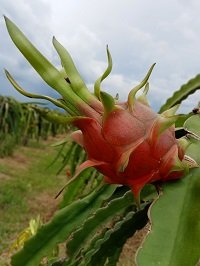Binh Thuan Dragon Fruit
| Registration Number | 110 |
|---|---|
| Name of the GI | Binh Thuan Dragon Fruit |
| Class | Fruit |
| Date of Protection | 2021/10/07 |
| Producing Area |
Overseas
Ham Tan, Ham Thuan Nam, Ham Thuan Bac and Bac Binh Districts and Phan Thiet City, all in Binh Thuan Province of Vietnam |
| Applicant - Name and Address | Hiệp hội Thanh long Bình Thuận (Binh Thuan Dragon Fruit Association) 17 Duong Thu Khoa Huan, Thanh Pho Phan Thiet, Tinh Binh Thuan, Vietnam |
Producing Area
"Binh Thuan Dragon Fruit" is characterized by being sweeter and less sour compared to dragon fruits cultivated in other areas of Vietnam. The freshness of the fruit and the dragon-like appearance can be relatively maintained even after long-distance transportation as it has thick fruit skin and thick and firm bracts. This ability to withstand long-distance transport is highly rated by distributors.
Binh Thuan Dragon Fruit was registered as a geographical indication in Vietnam in 2006 and has been a protected geographical indication in EU since 2020, when the European Union-Vietnam Free Trade Agreement entered into force.
White-flesh varieties are used. Only stem cuttings collected from superior trees in the production area via vegetative propagation are used. The trees are grown outdoors in the area; and flowering is stimulated by illumination culture from October to March. The fruits are thinned to one fruit per branch so that the nutrients condense into the fruit.
Only fruits that have no prominent injury or damage are allowed to be shipped.
The production area is located in the southernmost part of South Central Coast of Vietnam. The mean annual temperature is high, and the area is in the monsoon tropical climate zone, where it is very hot. This production area is characterized for receiving less annual rainfall compared to other production areas of dragon fruit. The climatic conditions in the area resemble those in the home of dragon fruit, i.e. the desert climate.
Production of dragon fruit in Binh Thuan started in the early years of 20th Century, and commercial production began in 1990. Today, it is exported to various regions of the world, including Asia, the Middle East, Europe, North America and Australia.


